Policy Gaps Related to Sustainability in Hungarian Agribusiness Development
Abstract
:1. Introduction
2. Sustainability Dilemmas about the CAP
3. Study Area
3.1. Environmental Conditions of Agriculture
3.2. Hungarian Agri-Food Policy after 1990
3.3. Economic Background
4. Materials and Methods
4.1. Materials
- Agrifood Concept of Hungary: made by the Ministry of Agriculture, it determines the need to increase the efficiency and competitiveness of domestic food production. In addition, it expresses the intention of Hungarian agricultural policy to make more intensive use of digital technologies to increase the efficiency of human resource management. Another frequently occurring ambition in the strategy is adapting the Industry 4.0 management approach and tools. The document builds on using CAP and EU funds (12.39 billion euros during the 2014–2020 programming period).
- EU Agricultural Outlook for markets, income, and environment: is a technical report of the European Commission, summarizing the main trends between 2021–2031, considering agricultural production and markets, land use, environmental aspects, and future scenarios.
- Digital Agricultural Strategy (DAS): is the fundamental document of our study and the current Hungarian Agricultural policy discourse. It was created within the national cross-sectoral digitalization program, the Digital Welfare Program. Resources are provided by the CAP and the National Rural Development Program. It aims to integrate digitalization achievements into agriculture and introduce Agriculture 4.0 in Hungary.
- Agricultural Labor Market Barometer Survey: was conducted by the Institute of Agricultural Economics Nonprofit LLC. (AKI), which sheds light on labor demand in the agricultural sector, exploring labor market trends in the Hungarian food economy.
- Digital Food Industry Strategy Summary (DFS): is closely linked to DAS, but it is not yet adopted, and currently, only a summary is available. In parallel with the DAS, the objectives of the DFS include a concrete action plan for the intensive use of digital, automatic, and robotic technologies. The two main pillars of the DFS are production technology development and education.
- European Green Deal (EGD): the European Commissions’ Green Deal is one of the primary policy instruments of the EU. From 2019 until 2050, it uses one-third of the funds available in the Multiannual Financial Framework of the EU (MFF) and the Next Generation EU program. In the frame of the EGD, Europe would become the first climate-neutral continent by 2050, resulting in a cleaner environment, more affordable energy, smarter transport, new jobs, and overall better quality of life.
- Farm to Fork Strategy (F2F): contributes to the EGD by shifting the EU food system to a more sustainable way. The leading indicators to be achieved are cutting pesticide use by 50%, reaching the objective of at least 25% of EU agricultural land under organic farming by 2030, and a significant increase in organic aquaculture. F2F relies on cohesion funds and the European Agricultural Fund for Rural Development (EAFRD).
- Regenerative agriculture in Europe: a critical analysis of contributions to the European Union F2F and Biodiversity Strategies. Localization and shortening the production and consumption chains based on local conditions and resources are the fundamental notions in this report. Localization means producing a diversity of products locally, in low-input systems, according to the local socio-economic context. Thus, the Scientific Advisory Board of the European Academies pointed out that the CAP and the European Structural and Investment Funds should be reallocated using best-fit farming practices at different scales.
4.2. Methods
5. Results
5.1. Sustainability Challenges in Hungarian Agribusiness
5.1.1. Environmental Problems in Agricultural Production
5.1.2. Problems Related to the Economic and Social Conditions of Production
5.1.3. Societal Challenges in the Food Economy
5.2. Policy Goals and Measures of Hungarian Agribusiness Development
6. Discussion
7. Conclusions
Author Contributions
Funding
Institutional Review Board Statement
Informed Consent Statement
Data Availability Statement
Conflicts of Interest
References
- Smalley, R.E. Future global energy prosperity: The terawatt challenge. MRS Bullet. 2005, 30, 412–417. [Google Scholar] [CrossRef]
- Schnebelin, É.; Labarthe, P.; Touzard, J.-M. How digitalisation interacts with ecologisation? Perspectives from actors of the French Agricultural Innovation System. J. Rural Stud. 2021, 86, 599–610. [Google Scholar] [CrossRef]
- Liu, Y.; Ma, X.; Shu, L.; Hancke, G.P.; Abu-Mahfouz, A.M. From Industry 4.0 to Agriculture 4.0: Current status, enabling technologies, and research challenges. IEEE Trans. Ind. Inform. 2021, 17, 4322–4334. [Google Scholar] [CrossRef]
- Lamine, C. Transition pathways towards a robust ecologization of agriculture and the need for system redesign. Cases from organic farming and IPM. J. Rural. Stud. 2011, 27, 209–219. [Google Scholar] [CrossRef]
- Friha, O.; Ferrag, M.A.; Shu, L.; Maglaras, L.; Wang, X. Internet of Things for the Future of Smart Agriculture: A Comprehensive Survey of Emerging Technologies. IEEE/CAA J. Autom. Sin. 2021, 8, 718–752. [Google Scholar] [CrossRef]
- El Bilali, H.; Allahyari, M.S. Transition towards sustainability in agriculture and food systems: Role of information and communication technologies. Inf. Process. Agric. 2018, 5, 456–464. [Google Scholar] [CrossRef]
- Maraux, F.; Malézieux, É.; Gary, C. From artificialization to the ecologization of cropping systems. In Cultivating Biodiversity to Transform Agriculture; Hainzelin, É., Ed.; Springer: Dordrecht, The Netherlands, 2013; pp. 45–90. [Google Scholar] [CrossRef]
- Pe’er, G.; Bonn, A.; Bruelheide, H.; Dieker, P.; Eisenhauer, N.; Feindt, P.H.; Hagedorn, G.; Hansjürgens, B.; Herzon, I.; Lomba, A.; et al. Action needed for the EU Common Agricultural Policy to address sustainability challenges. People Nat. 2020, 2, 305–316. [Google Scholar] [CrossRef]
- Bański, J. Spatial differences in the transformation processes taking place in rural areas of East-Central Europe. In Three Decades of Transformation in the East-Central European Countryside, 1st ed.; Bański, J., Ed.; Springer: Cham, Switzerland, 2019; pp. 3–19. [Google Scholar] [CrossRef]
- EEA Report No 10/2017. Landscapes in Transition: An Account of 25 Years of Land Cover Change in Europe. 2017. Available online: https://www.eea.europa.eu/publications/landscapes-in-transition (accessed on 17 May 2022).
- Henle, K.; Alard, D.; Clitherow, J.; Cobb, P.; Firbank, L.; Kull, T.; McCracken, D.; Moritz, F.A.R.; Niemalä, J.; Rebane, M.; et al. Identifying and managing the conflicts between agriculture and biodiversity conservation in Europe–A review. Agric. Ecosyst. Environ. 2008, 124, 60–71. [Google Scholar] [CrossRef]
- Crenna, E.; Sinkko, T.; Sala, S. Biodiversity impacts due to food consumption in Europe. J. Clean. Prod. 2019, 227, 378–391. [Google Scholar] [CrossRef]
- EEA Report No 5/2018. Annual European Union Greenhouse Gas Inventory 1990–2016 and Inventory Report. 2018. Available online: https://www.eea.europa.eu/publications/european-union-greenhouse-gas-inventory-2018/at_download/file (accessed on 17 May 2022).
- EEA. Land Cover Country Fact Sheets 2008–2018. 2021. Available online: https://www.eea.europa.eu/themes/landuse/land-cover-country-fact-sheets?b_start:int=0 (accessed on 18 May 2022).
- Carvalho, F.P. Pesticides, environment, and food safety. Food Energy Secur. 2017, 6, 48–60. [Google Scholar] [CrossRef]
- EC. Integrating Environmental Concerns Into the CAP. Agriculture and Rural Development. 2017. Available online: https://ec.europa.eu/agriculture/envir/cap_en (accessed on 21 May 2022).
- Bowler, I.R.; Ilbery, B.W. From agricultural productivism to post-productivism. In The Geography of Rural Change; Ilbery, B.W., Ed.; Routledge: London, UK, 1998; pp. 57–84. [Google Scholar]
- Feindt, P.H. EU agricultural policy. In Handbook of European Policies; Helnelt, H., Münch, S., Eds.; Edward Elgar Publishing: Cheltenham, UK, 2018; pp. 115–133. [Google Scholar]
- Solazzo, R.; Donati, M.; Tomasi, L.; Arfini, F. How effective is greening policy in reducing GHG emissions from agriculture? Evidence from Italy. Sci. Total Environ. 2016, 573, 1115–1124. [Google Scholar] [CrossRef] [PubMed]
- Gkartzios, M.; Lowe, P. Revisiting neo-endogenous rural development. In The Routledge Companion to Rural Planning; Scott, M., Gallent, N., Gkartzios, M., Eds.; Routledge: New York, NY, USA, 2019; pp. 159–169. [Google Scholar]
- De Schutter, O.; Jacobs, N.; Clément, C. A ‘Common Food Policy’ for Europe: How governance reforms can spark a shift to healthy diets and sustainable food systems. Food Policy 2020, 96, 101849. [Google Scholar] [CrossRef]
- Pe’er, G.; Lakner, S. The EU’s Common Agricultural Policy Could Be Spent Much More Efficiently to Address Challenges for Farmers, Climate, and Biodiversity. One Earth 2020, 3, 173–175. [Google Scholar] [CrossRef]
- Lovec, M.; Šumrada, T.; Erjavec, E. New CAP Delivery Model, Old Issues. Intereconomics 2020, 55, 112–119. [Google Scholar] [CrossRef]
- Erjavec, E.; Lovec, M.; Juvančič, L.; Šumrada, T.; Rac, I. Research for AGRI Committee—The CAP Strategic Plans beyond 2020: Assessing the Architecture and Governance Issues in Order to Achieve the EU-Wide Objectives, European Parliament, Policy Department for Structural and Cohesion Policies. 2018. Available online: https://www.europarl.europa.eu/RegData/etudes/STUD/2018/617501/IPOL_STU(2018)617501_EN.pdf (accessed on 28 May 2022).
- Heinemann, F.; Weiss, S. The EU Budget and Common Agricultural Policy Beyond 2020: Seven More Years of Money for Nothing? EconPol Working Paper No. 17; ifo Institute—Leibniz Institute for Economic Research at the University of Munich: Munich, Germany, 2018; Available online: http://hdl.handle.net/10419/219479 (accessed on 17 May 2022).
- Tarjuelo, R.; Margalida, A.; Mougeot, F. Changing the fallow paradigm: A win–win strategy for the post-2020 Common Agricultural Policy to halt farmland bird declines. J. Appl. Ecol. 2020, 57, 642–649. [Google Scholar] [CrossRef]
- European Court of Auditors (ECA). Greening a More Complex Income Support Scheme, Not Yet Environmentally Effective. 2017. Available online: https://www.eca.europa.eu/Lists/ECADocuments/SR17_21/SR_GREENING_EN.pdf (accessed on 17 May 2022).
- Brady, M.; Hristov, J.; Höjgård, S.; Jansson, T.; Johansson, H.; Larsson, C.; Nordin, I.; Rabinowicz, E. Impacts of Direct Payments–Lessons for CAP Post-2020 from a Quantitative Analysis; AgriFood Economics Centre: Lund, Sweden, 2017; Available online: https://pub.epsilon.slu.se/16201/7/brady_m_et_al_190614.pdf (accessed on 22 May 2022).
- Alons, G. Environmental policy integration in the EU’s common agricultural policy: Greening or greenwashing? J. Eur. Public Policy 2017, 24, 1604–1622. [Google Scholar] [CrossRef]
- Recanati, F.; Maughan, C.; Pedrotti, M.; Dembska, K.; Antonelli, M. Assessing the role of CAP for more sustainable and healthier food systems in Europe: A literature review. Sci. Total Environ. 2019, 653, 908–919. [Google Scholar] [CrossRef]
- Scown, M.W.; Nicholas, K.A. European agricultural policy requires a stronger performance framework to achieve the Sustainable Development Goals. Glob. Sustain. 2020, 3, e11. [Google Scholar] [CrossRef] [Green Version]
- Matthews, A. The new CAP must be linked more closely to the UN Sustainable Development Goals. Agric. Food Econ. 2020, 8, 19. [Google Scholar] [CrossRef]
- Kondratieva, N.B. EU Agricultural Digitalization Decalogue. Her. Russ. Acad. Sci. 2021, 91, 736–742. [Google Scholar] [CrossRef]
- Rijswijk, K.; Klerkx, L.; Bacco, M.; Bartolini, F.; Bulten, E.; Debruyne, L.; Dessein, J.; Scotti, I.; Brunori, G. Digital transformation of agriculture and rural areas: A socio-cyber-physical system framework to support responsibilisation. J. Rural Stud. 2021, 85, 79–90. [Google Scholar] [CrossRef]
- NAK (The Hungarian Chamber of Agriculture). Strengthening Agriculture and Food Processing Industry, Prospering Rural Areas (Erősödő Agrár-És Élelmiszergazdaság, Jólétében Gyarapodó Vidék). 2018. Available online: http://nak.hu/kiadvanyok/kiadvanyok/2301-erosodo-agrar-es-elelmiszer-gazdasag-joleteben-gyarapodo-videk/file (accessed on 11 May 2022).
- Kertész, Á.; Křeček, J. Landscape degradation in the world and in Hungary. Hung. Geogr. Bull. 2019, 68, 201–221. [Google Scholar] [CrossRef]
- OMSZ (Hungarian Meterological Service) Climate Change—Observed Changes—Hungary. 2018. Available online: https://www.met.hu/eghajlat/eghajlatvaltozas/megfigyelt_hazai_valtozasok/homerseklet_es_csapadektrendek/ (accessed on 11 May 2022).
- Gaál, M.; Quiroga, S.; Fernandez-Haddad, Z. Potential impacts of climate change on agricultural land use suitability of the Hungarian counties. Reg Environ. Chang. 2014, 14, 597–610. [Google Scholar] [CrossRef]
- Csáki, C.; Lerman, Z. Land reform and farm restructuring in East Central Europe and CIS in the 1990s: Expectations and achievements after the first five years. Eur. Rev. Agric. Econ. 1997, 24, 428–452. [Google Scholar] [CrossRef]
- NAK (The Hungarian Chamber of Agriculture). Agri-Environment Measures in the EU. Handbook for Farmers (Agrár-környezetgazdálkodás. Kézikönyv a Támogatási Kérelem Benyújtásához). 2016. Available online: http://nak.hu/kiadvanyok/kiadvanyok/130-akg-kezikonyv/file (accessed on 11 May 2022).
- Állami Számvevőszék (State Audit Office of Hungary). An Overview and Evaluation of EU Financial Subsidies in the Budgetary Period of 2007–2013 (Tanulmány a 2007–2013. évi EU Költségvetési Időszakban Magyarország Részére Juttatott közösségi Támogatások Összefoglaló Bemutatásáról, Értékeléséről). 2015. Available online: https://www.asz.hu/storage/files/files/Publikaciok/Elemzesek_tanulmanyok/2015/2007_2013_eu_koltsegvetesi_idoszakban_magyarorszag_reszere_juttatott_kozossegi_tamogatasok_osszefoglalo_bemutatasa_ertekelese.pdf?ctid=855 (accessed on 11 May 2022).
- Földművelésügyi Minisztérium (The Hungarian Ministry of Agriculture). The Darányi Ignác Plan: The Framework for Carrying Out the National Rural Development Programme of Hungary (Darányi Ignác terv a Nemzeti Vidékstratégia (NVS 2012–2020) Végrehajtásának Keretprogramja). 2012. Available online: http://videkstrategia.kormany.hu/download/4/ae/40000/DIT2_magyar_t%C3%B6rdelt_120910.pdf (accessed on 11 May 2022).
- OH (Office of the Parliament). Agricultural Subsidies (Agrártámogatások). 2019. Available online: https://www.parlament.hu/documents/10181/1789217/Infojegyzet_2019_7_agrartamogatasok.pdf/6ae0b71a-a535-8ca7-25e5-9dee2b3f38b4 (accessed on 11 May 2022).
- AKI Pénzügyi Hírlevél (Agricultural Economics Nonprofit LLC Financial Newsletter). 2022; Volume 15, 1. Available online: http://repo.aki.gov.hu/3896/1/Penzugyi_Hirlevel_2022_01.pdf (accessed on 23 June 2022).
- KSH (Hungarian Central Statistical Office). Statistical Reflections—Agricultural Land Prices and Rents in 2015 (Statisztikai Tükör—Mezőgazdasági termőföldárak és Bérleti Díjak, 2015). 2016. Available online: http://www.ksh.hu/docs/hun/xftp/stattukor/mgfoldarak/mgfoldarak15.pdf (accessed on 11 May 2022).
- Kovách, I. The Countryside at the Turn of the Millennium: Changing Structures and Power Relations in Contemporary Hungarian Rural Society (A Vidék az Ezredfordulón: A Jelenkori Magyar Vidéki Társadalom Szerkezeti és Hatalmi Változásai); MTA Társadalomtudományi Kutatóközpont Szociológiai Intézet–Argumentum Kiadó: Budapest, Hungary, 2012; pp. 1–241. [Google Scholar]
- OECD. Environmental Impacts of OECD Agriculture after 1990: Hungary. (Az OECD Mezőgazdaságának Környezetvédelmi Hatásai 1990 után: Magyarország). 2008. Available online: http://www.oecd.org/dataoecd/10/36/40801754.pdf (accessed on 11 June 2022).
- Baráth, L.; Fertő, I.; Hockmann, H. Technological differences, theoretical consistency, and technical efficiency: The case of Hungarian crop-producing farms. Sustainability 2020, 12, 1147. [Google Scholar] [CrossRef]
- Gilbert, M.; Slingenbergh, J.; Xiao, X. Climate change and avian influenza. Rev. Sci. Tech. Int. Off. Epizoot. 2008, 27, 459–466. [Google Scholar] [CrossRef]
- Bergmann, H.; Schulz, K.; Conraths, F.J.; Sauter-Louis, C. A review of environmental risk factors for African Swine Fever in European wild boar. Animals 2021, 11, 2692. [Google Scholar] [CrossRef]
- Srivastava, A.; Thomson, S.B. Framework Analysis: A Qualitative Methodology for Applied Policy Research. J. Adm. Governance 2009, 4, 72–79. Available online: https://ssrn.com/abstract=2760705 (accessed on 12 August 2022).
- Rädiker, S.; Kuckartz, U. Analyse Qualitativer Daten mit MAXQDA, 1st ed.; Springer: Wiesbaden, Germany, 2019; pp. 53–66. [Google Scholar]
- Bizottsági Szolgálati Munkadokumentum (Commission Staff Working Paper). 2022. Évi Országjelentés—Magyarország (Country Report of Hungary). 2022. Available online: https://ec.europa.eu/info/sites/default/files/2022-european-semester-country-report-hungary_hu.pdf (accessed on 30 May 2022).
- Kamp, J.; Urazaliev, R.; Donald, P.F.; Hölzel, N. Post-Soviet agricultural change predicts future declines after recent recovery in Eurasian steppe bird populations. Biol. Conserv. 2011, 144, 2607–2614. [Google Scholar] [CrossRef]
- Marques, A.T.; Moreira, F.; Alcazar, R.; Delgado, A.; Godinho, C.; Sampaio, H.; Rocha, P.; Sequeira, N.; Palmeirim, J.M.; Silva, J.P. Changes in grassland management and linear infrastructures associated to the decline of an endangered bird population. Sci. Rep. 2020, 10, 15150. [Google Scholar] [CrossRef]
- Zafra, A. A Food Waste Urban Approach—To Reduce the Depletion of Natural Resources, Limit Environmental Impacts, and Make the Food System More Circular. Urbact, Driving Change for Better Cities. 2022. Available online: https://urbact.eu/food-waste-urban-approach-reduce-depletion-natural-resources-limit-environmental-impacts-and-make (accessed on 11 June 2022).
- Stenmarck, Å.; Jensen, C.M.; Quested, T.; Motes, G. Estimates of European Food Waste Levels. 2016. Available online: https://www.researchgate.net/publication/301216380_Estimates_of_European_food_waste_levels (accessed on 20 June 2022).
- Finger, R.; Swinton, S.M.; El Benni, N.; Walter, A. Precision farming at the nexus of agricultural production and the environment. Annu. Rev. Resour. Econ. 2019, 11, 313–335. [Google Scholar] [CrossRef]
- McBratney, A.; Whelan, B.; Ancev, T.; Bouma, J. Future directions of precision agriculture. Precis. Agric. 2005, 6, 7–23. [Google Scholar] [CrossRef]
- Fraser, A. ‘You can’t eat data’?: Moving beyond the misconfigured innovations of smart farming. J. Rural. Stud. 2022, 91, 200–207. [Google Scholar] [CrossRef]
- Brown, G. Dirt to Soil. One Family’s Jorney into Regenerative Agriculture; Chelsea Green Publishing: London, UK, 2018; p. 224. [Google Scholar]
- Sherwood, A.; Uphoff, N. Soil health: Research, practice and policy for a more regenerative agriculture. Appl. Soil Ecol. 2000, 15, 85–97. [Google Scholar] [CrossRef]
- Rhodes, C.J. Feeding and healing the world: Through regenerative agriculture and permaculture. Sci. Prog. 2012, 95, 345–446. [Google Scholar] [CrossRef] [PubMed]
- Rhodes, C.J. The imperative for regenerative agriculture. Sci. Prog. 2017, 100, 80–129. [Google Scholar] [CrossRef]
- Wheeler, T.; Von Braun, J. Climate change impacts on global food security. Science 2013, 341, 508–513. [Google Scholar] [CrossRef]
- Gitz, V.; Meybeck, A.; Lipper, L.; Young, C.D.; Braatz, S. Climate Change and Food Security: Risks and Responses. Food and Agriculture Organization of the United Nations (FAO) Report, 110. 2015. Available online: https://www.fao.org/3/i5188e/i5188e.pdf. (accessed on 1 June 2022).
- Balafoutis, A.; Beck, B.; Fountas, S.; Vangeyte, J.; van der Wal, T.; Soto, I.; Gómez-Barbero, M.; Barnes, A.; Eory, V. Precision Agriculture Technologies Positively Contributing to GHG Emissions Mitigation, Farm Productivity and Economics. Sustainability 2017, 9, 1339. [Google Scholar] [CrossRef]
- Skinner, C.; Gattinger, A.; Krauss, M.; Krause, H.-M.; Mayer, J.; van der Heijden, M.G.A.; Mäder, P. The impact of long-term organic farming on soil-derived greenhouse gas emissions. Sci. Rep. 2019, 9, 1702. [Google Scholar] [CrossRef] [Green Version]
- Squalli, J.; Adamkiewicz, G. Organic farming and greenhouse gas emissions: A longitudinal U.S. state-level study. J. Clean. Prod. 2018, 192, 30–42. [Google Scholar] [CrossRef]
- Pimentel, D.; Burgess, M. An Environmental, Energetic and Economic Comparison of Organic and Conventional Farming Systems. In Integrated Pest Management; Pimentel, D., Peshin, R., Eds.; Springer: Dordrecht, The Netherlands, 2014; pp. 141–166. [Google Scholar] [CrossRef]
- MacRae, R.J.; Lynch, D.; Martin, R.C. Improving Energy Efficiency and GHG Mitigation Potentials in Canadian Organic Farming Systems. J. Sustain. Agric. 2010, 34, 549–580. [Google Scholar] [CrossRef]
- Hepperly, P.R.; Douds, D.; Seidel, R. The Rodale Institute Farming Systems Trial 1981 to 2005: Long-term analysis of organic and conventional maize and soybean cropping systems. In Long-Term Field Experiments in Organic Farming; Raupp, J., Ed.; Verlag Dr Köster: Berlin, Germany, 2006; pp. 15–31. [Google Scholar]
- Moyer, J. Perspective on Rodale Institute’s Farming Systems Trial. Crop Manag. 2013, 12, 1–3. [Google Scholar] [CrossRef]
- Simoniello, T.; Coluzzi, R.; D’Emilio, M.; Imbrenda, V.; Salvati, L.; Sinisi, R.; Summa, V. Going. Conservative or Conventional? Investigating Farm Management Strategies in between Economic and Environmental Sustainability in Southern Italy. Agronomy 2022, 12, 597. [Google Scholar] [CrossRef]
- Paarlberg, R. The trans-Atlantic conflict over “green” farming. Food Policy 2022, 108, 102229. [Google Scholar] [CrossRef]
- Seufert, V.; Ramankutty, N.; Foley, J.A. Comparing the yields in organic and conventional agriculture. Nature 2012, 485, 229–234. [Google Scholar] [CrossRef]
- Agrimonti, C.; Lauro, M.; Visioli, G. Smart agriculture for food quality: Facing climate change in the 21st century. Crit. Rev. Food Sci. Nutr. 2021, 61, 971–981. [Google Scholar] [CrossRef]
- Lal, R. Regenerative agriculture for food and climate. J. Soil Water Conserv. 2020, 75, 123A–124A. [Google Scholar] [CrossRef]
- Moraru, P.I.; Teodor, R. Soil tillage conservation and its effect on soil organic matter, water management and carbon sequestration. J. Food Agric. Environ. 2010, 8, 309–312. [Google Scholar]
- Rawls, W.J.; Pachepsky, Y.A.; Ritchie, J.C.; Sobecki, T.M.; Bloodworth, H. Effect of soil organic carbon on soil water retention. Geoderma 2003, 116, 61–76. [Google Scholar] [CrossRef]
- Mormont, M. Rural nature and urban natures. Sociol. Rural 1987, 27, 1–20. [Google Scholar] [CrossRef]
- Ren, K. Following Rural Functions to Classify Rural Sites: An Application in Jixi, Anhui Province, China. Land 2021, 10, 418. [Google Scholar] [CrossRef]
- Lontai-Szilágyi, Z.; Bertalan-Balázs, B.; Zsiros, B.; Vasvári, M.; Kumar, S.S.; Nilanchal, P.; Martonné Erdős, K.; Szabó, S. A novel approach of mapping landscape aesthetic value and its validation with rural tourism data. Hung. Geogr. Bull. 2019, 68, 283–301. [Google Scholar] [CrossRef]
- Opdam, P. Exploring the role of science in sustainable landscape management. An introduction to the special issue. Sustainability 2018, 10, 331. [Google Scholar] [CrossRef]
- Farkas, J.Z.; Kovács, A.D. Nature conservation versus agriculture in the light of socio-economic changes over the last half-century–Case study from a Hungarian national park. Land Use Policy 2021, 101, 105131. [Google Scholar] [CrossRef]
- Balogh, P.; Bai, A.; Czibere, I.; Kovách, I.; Fodor, L.; Bujdos, Á.; Sulyok, D.; Gabnai, Z.; Birkner, Z. Economic and social barriers of precision farming in Hungary. Agronomy 2021, 11, 1112. [Google Scholar] [CrossRef]
- Walter, A.; Finger, R.; Huber, R.; Buchmann, N. Smart farming is key to developing sustainable agriculture. Proc. Natl. Acad. Sci. USA 2017, 114, 6148–6150. [Google Scholar] [CrossRef]
- Weersink, A.; Fraser, E.; Pannell, D.; Duncan, E.; Rotz, S. Opportunities and challenges for big data in agricultural and environmental analysis. Annu. Rev. Resour. Econ. 2018, 10, 19–37. [Google Scholar] [CrossRef]
- Maloku, D. Adoption of precision farming technologies: USA and EU situation. SEA–Pract. Appl. Sci. 2020, 8, 7–14. Available online: https://seaopenresearch.eu/Journals/articles/SPAS_22_1.pdf. (accessed on 1 June 2022).
- NPHMOS. A Comprehensive Study Has Been Conducted on the Economic Effects of the Public Health Product Tax (Átfogó Vizsgálat Készült a Népegészségügyi Termékadó Gazdasági Hatásairól). 2013. Available online: https://tinyurl.com/4v47st9n (accessed on 20 June 2022).
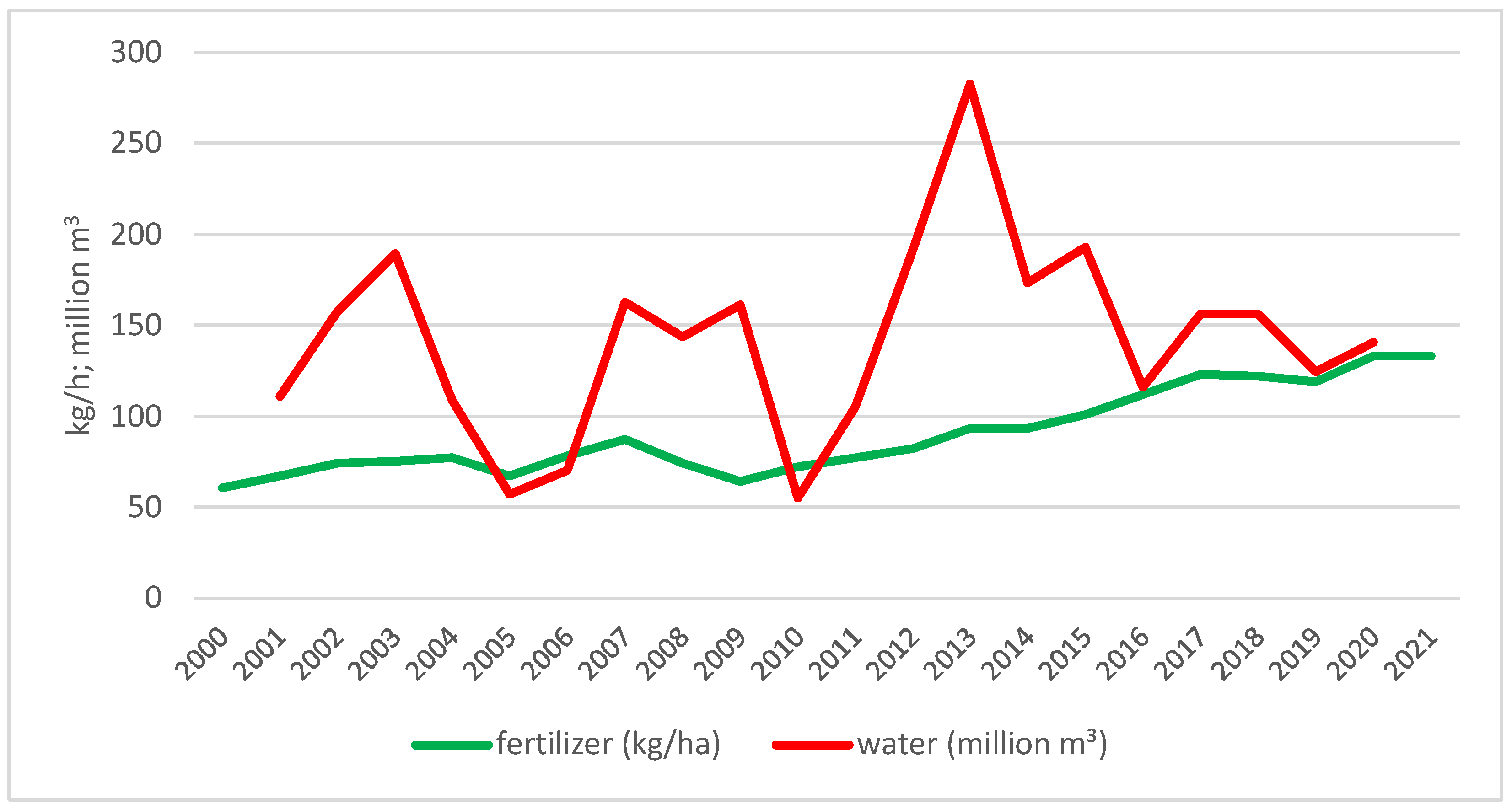
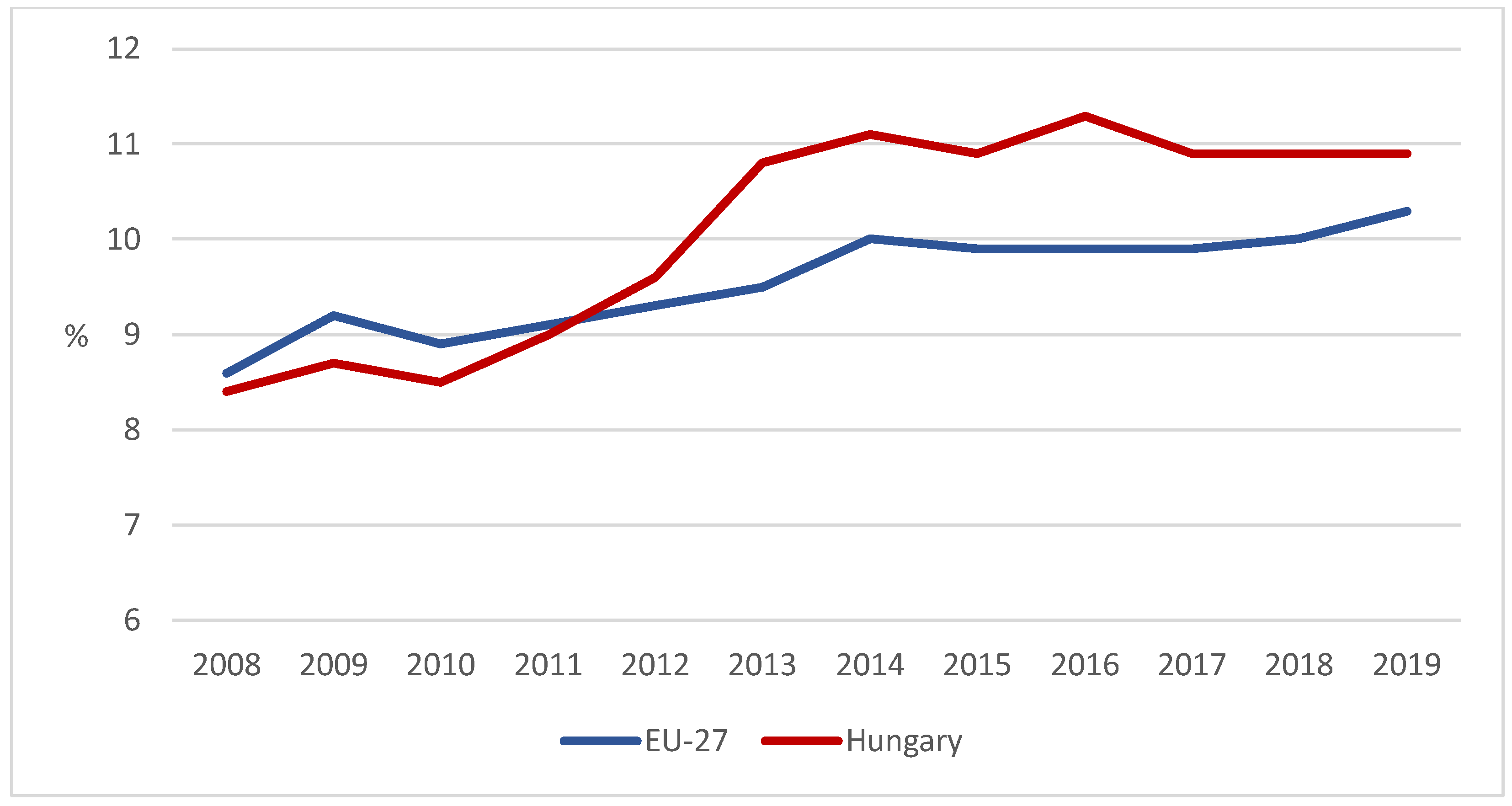
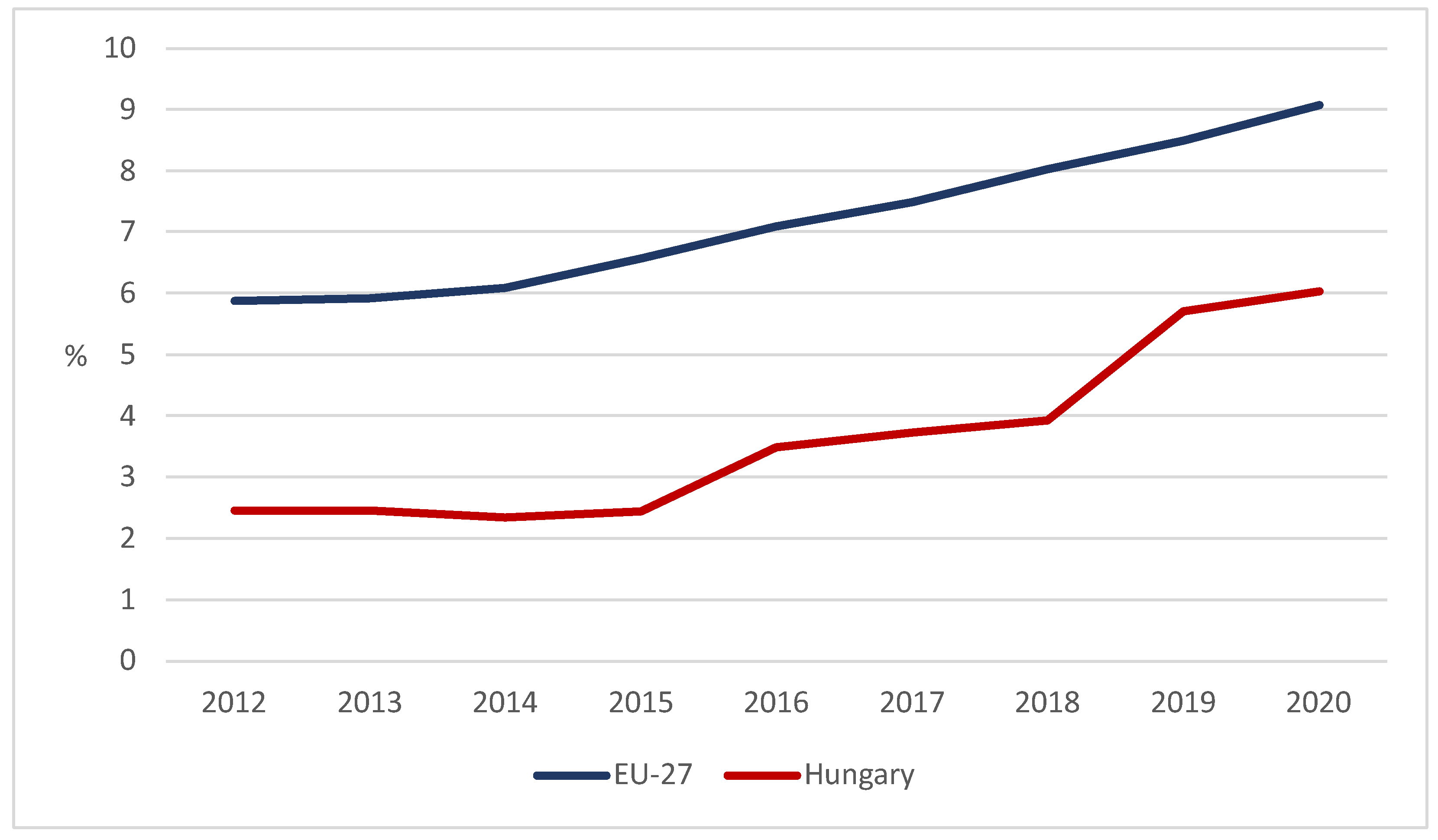
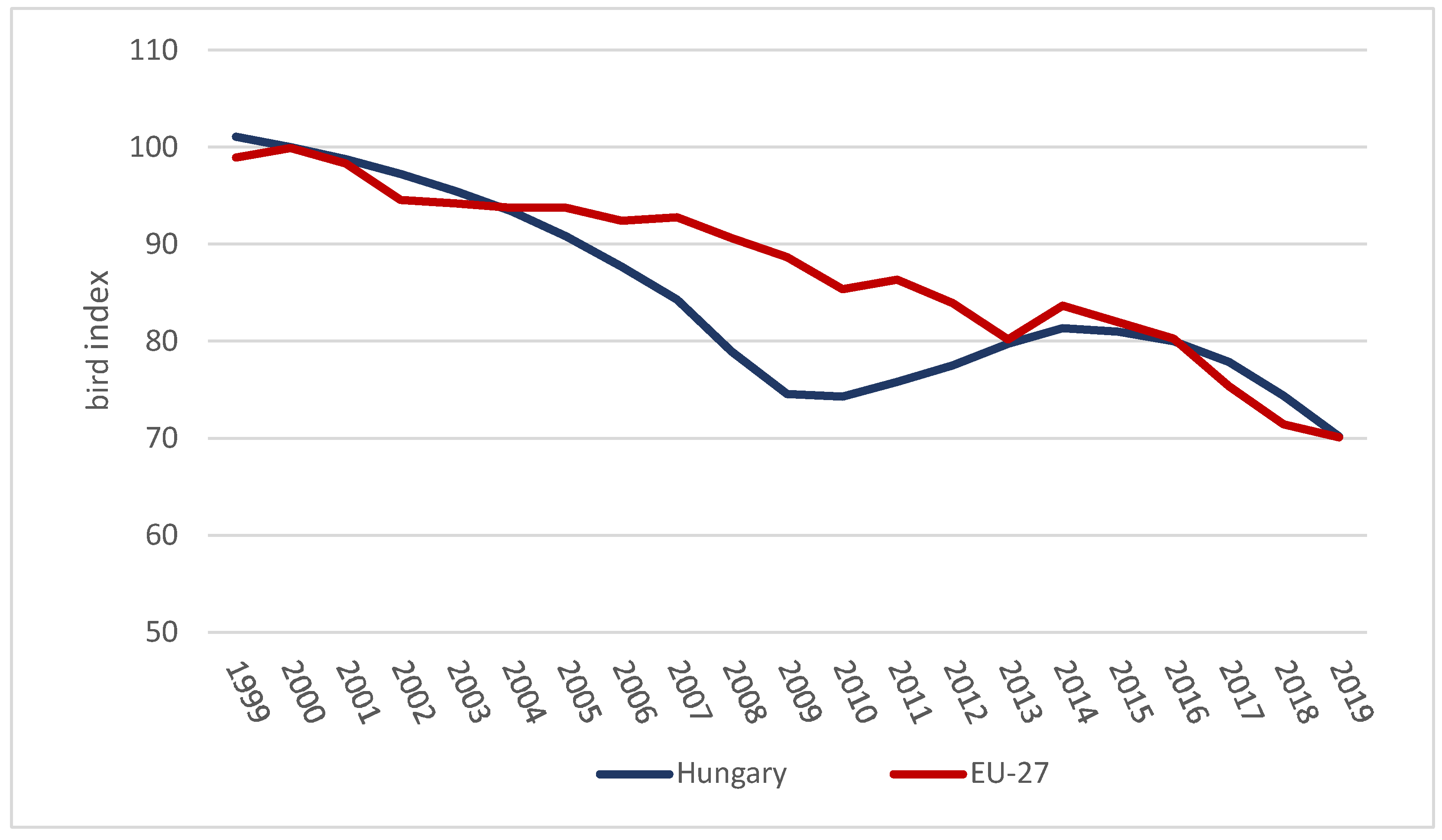
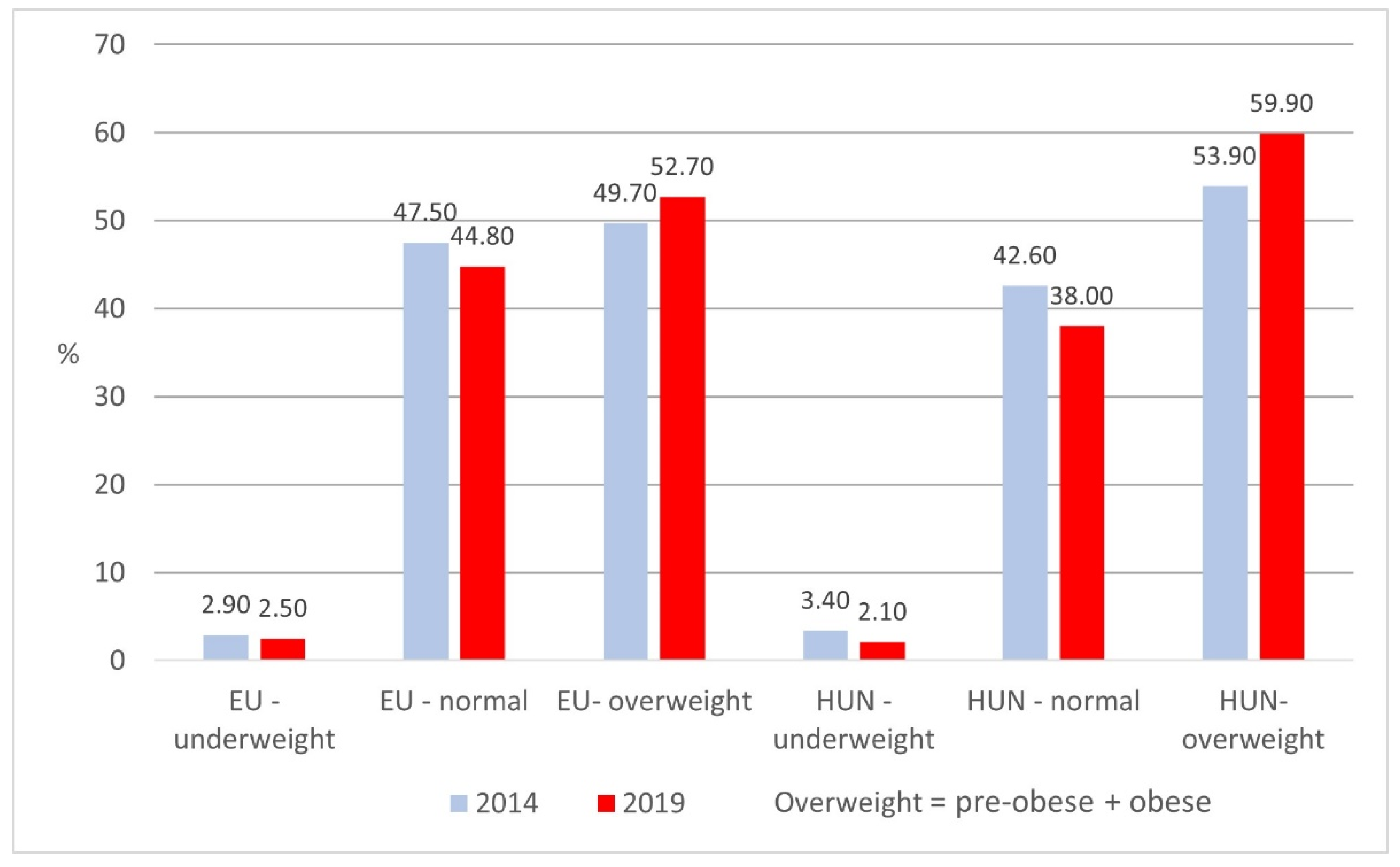
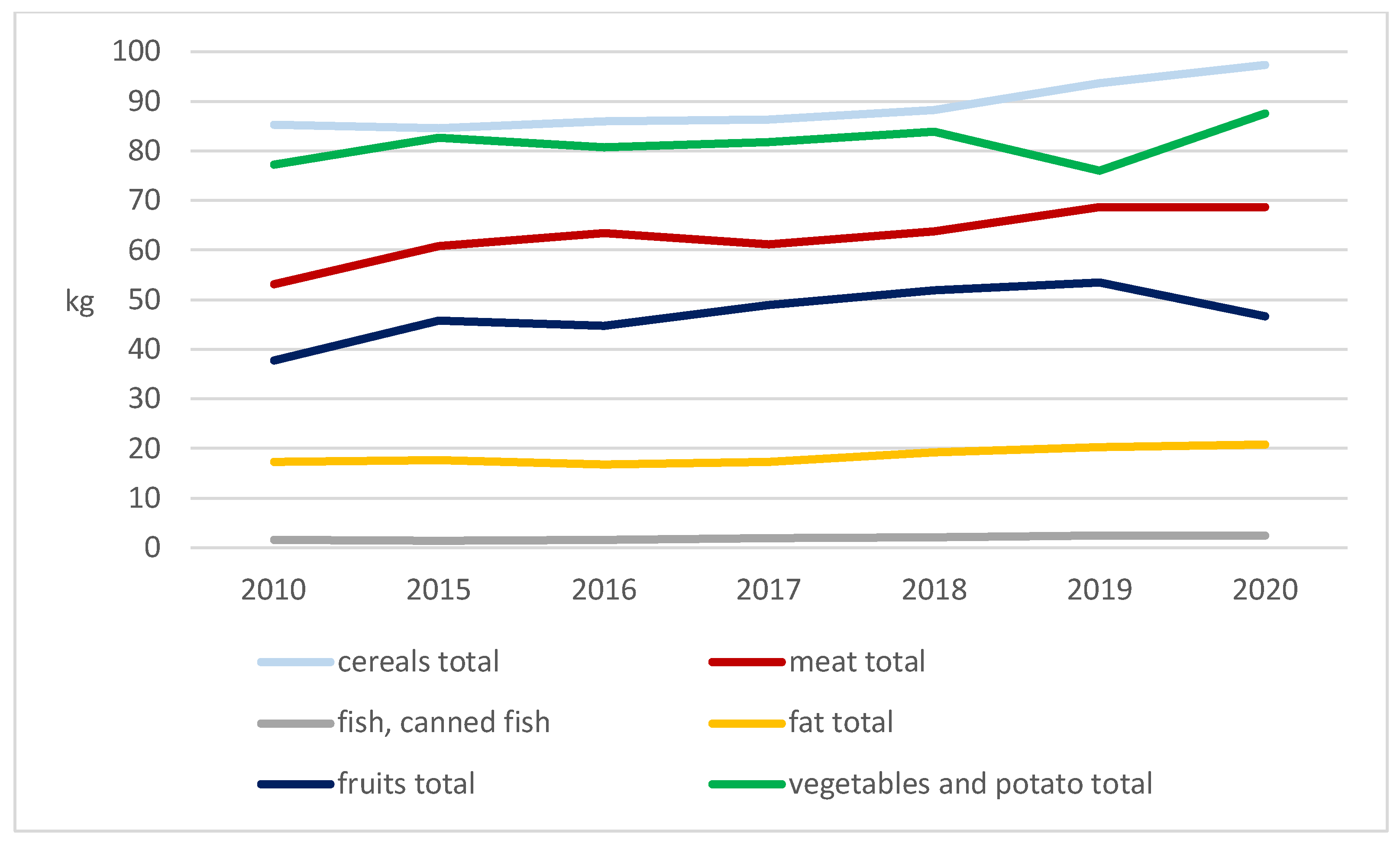
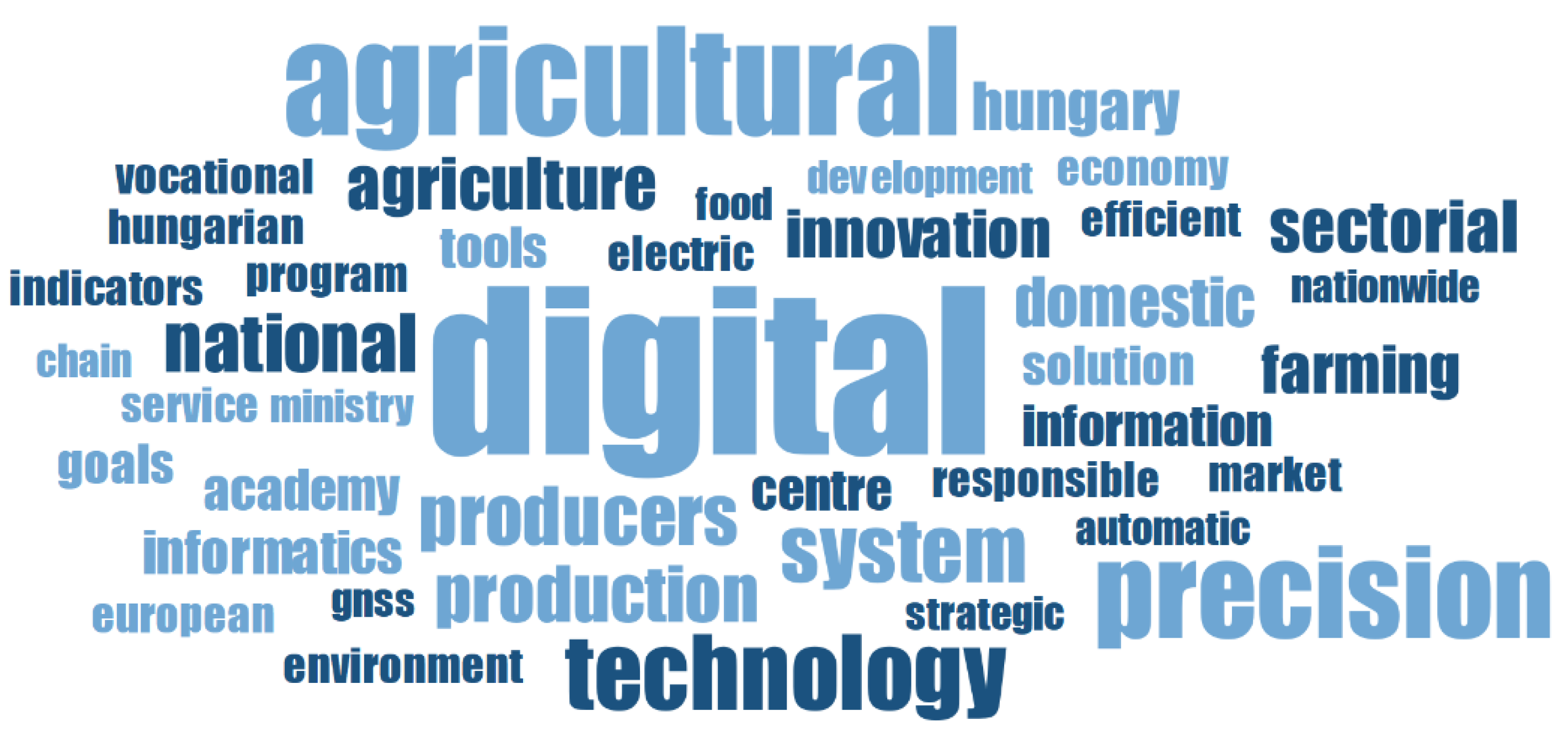
| Agriculture and Food Industry | 1989/1990 | 1997 | 2004 | 2016 | Change 1990–2016 |
|---|---|---|---|---|---|
| Production and investment | |||||
| Agriculture share in GDP (%) | 13.7 | 5.9 | 3.9 | 4.4 | −9.3 |
| Food-industry share in GDP (%) | 5.2 | 3.7 | 2.8 | 2.2 | /−3 |
| Utilized agricultural area (1000 ha) | 6473.1 | 6194.6 | 5863.8 | 5349 | −1124.1 |
| Trade | |||||
| Share in export % | 22.4 * | 15 | 6.9 | 8.6 | −13.8 |
| Share in import % | 6.4 * | 5.1 | 4.1 | 5.49 | −0.91 |
| Balance (million HUF) | 109.362 * | 332.343 | 275.815 | 816.000 | 706.638 |
| Employment | |||||
| Employed in agriculture, forestry and fishery (1000 person) | 693 | 288 | 205 | 217 | −476 |
| Employment in food industry (1000 person) | 234 | 160 | 141 | 143.8 | −90.2 |
| Share of total employment (%) | 19 | 12.29 | 8.87 | 8.29 | −10.71 |
| Production of cereals (1000 t) | |||||
| Wheat | 6161.4 | 5257.6 | 6006.8 | 5603.1 | −558.3 |
| Maize | 4257.7 | 6827.7 | 8332.4 | 8729.9 | 4472.2 |
| Barley | 1357.6 | 1330.2 | 1413.3 | 1594.2 | 236.6 |
| Production of main industrial crops (1000 t) | |||||
| Sunflower seeds | 677.3 | 540.2 | 1186.1 | 1875.4 | 1198.1 |
| Rape seeds | 104.4 | 144.8 | 290.5 | 924.9 | 820.5 |
| Sugar beet | 4740.9 | 3690.9 | 3515.8 | 1121.2 | −3619.7 |
| Production of potato, grapes, vegetables, and fruits (1000 t) | |||||
| Potato | 745.5 | 1139.5 | 783.6 | 429.4 | −316.1 |
| Vineyard | 862.9 | 649.5 | 788.6 | 476.4 | −386.5 |
| Tomatoes | 403.8 | 219.7 | 269.2 | 173 | −230.8 |
| Apple | 945.4 | 499.9 | 700.3 | 497.1 | −448.3 |
| Number of livestock Units (1000 heads) | |||||
| Cattle | 1571 | 871 | 723 | 852 | −719 |
| Pigs | 8000 | 4931 | 4059 | 2907 | −5093 |
| Sheep | 1865 | 858 | 1397 | 1141 | −724 |
| Poultry | 50,011 | 35.665 | 41.329 | 40.185 | −9826 |
Publisher’s Note: MDPI stays neutral with regard to jurisdictional claims in published maps and institutional affiliations. |
© 2022 by the authors. Licensee MDPI, Basel, Switzerland. This article is an open access article distributed under the terms and conditions of the Creative Commons Attribution (CC BY) license (https://creativecommons.org/licenses/by/4.0/).
Share and Cite
Hoyk, E.; Szalai, Á.; Palkovics, A.; Farkas, J.Z. Policy Gaps Related to Sustainability in Hungarian Agribusiness Development. Agronomy 2022, 12, 2084. https://doi.org/10.3390/agronomy12092084
Hoyk E, Szalai Á, Palkovics A, Farkas JZ. Policy Gaps Related to Sustainability in Hungarian Agribusiness Development. Agronomy. 2022; 12(9):2084. https://doi.org/10.3390/agronomy12092084
Chicago/Turabian StyleHoyk, Edit, Ádám Szalai, András Palkovics, and Jenő Zsolt Farkas. 2022. "Policy Gaps Related to Sustainability in Hungarian Agribusiness Development" Agronomy 12, no. 9: 2084. https://doi.org/10.3390/agronomy12092084
APA StyleHoyk, E., Szalai, Á., Palkovics, A., & Farkas, J. Z. (2022). Policy Gaps Related to Sustainability in Hungarian Agribusiness Development. Agronomy, 12(9), 2084. https://doi.org/10.3390/agronomy12092084






